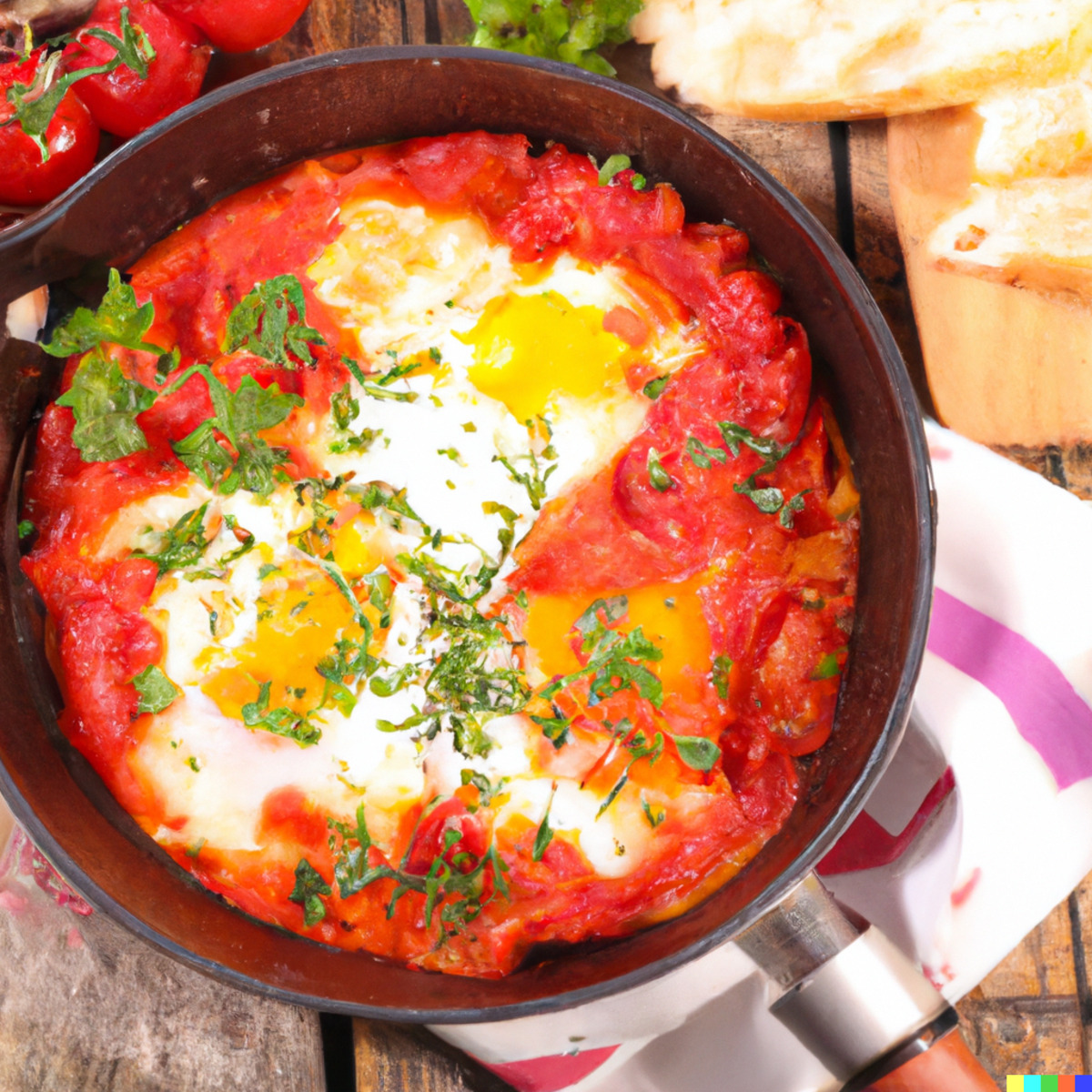
Jump to:
There's something so comforting about diving into a skillet of shakshuka. This North African and Mediterranean favorite is a one-pan wonder that combines simple ingredients into an extraordinary meal. Imagine a bubbling sauce of ripe tomatoes, aromatic spices, and sautéed veggies, all crowned with perfectly poached eggs. The rich, velvety yolks blend seamlessly into the sauce, making each bite a perfect harmony of flavors. It's the kind of dish that's equally suitable for a lazy Sunday brunch or a quick weeknight dinner.
I love how easily this dish comes together. Start by softening onions and bell peppers in olive oil, then layer in spices like cumin and paprika for depth and warmth. The crushed tomatoes form the base of this saucy dish, creating a canvas for the eggs to poach in. And don't forget the crowning glory—a sprinkle of fresh herbs, like parsley or cilantro, adds that final flourish. Serve it up with crusty bread or pita, and you've got a meal that's as satisfying as it is Instagram-worthy. Trust me, after you've had a taste of shakshuka, you'll wonder how you ever lived without it.
The Origins of Shakshuka
Shakshuka is a dish that captivates hearts and palates, but its origins are as complex and rich as its flavors. Widely considered to be a North African invention, particularly from Tunisia, shakshuka has made its way across different cultures and kitchens, becoming a staple in countries like Israel, Libya, and Egypt. The name "shakshuka" itself is thought to come from either Arabic or Berber languages, generally interpreted to mean "a mixture" or "shaken," aptly describing the medley of ingredients that go into the dish.
In North Africa, this beloved concoction often featured a spicy tomato and pepper base, with local spices giving it a distinct flair. When Jewish immigrants from North Africa moved to Israel, they brought shakshuka with them, where it quickly gained popularity and became integrated into local cuisine. Over time, the dish has been adapted and embellished with new ingredients and techniques. Today, you'll find variations that include different meats, cheeses, and even seafood. Despite its complex journey, the core essence of shakshuka has remained the same—a comforting, communal dish that brings people together over a shared love of good food. Whether you're enjoying a traditional version or experimenting with your own twist, each bite is a nod to the rich tapestry of cultures that have contributed to this culinary gem.
Instructions: How to Make Perfect Shakshuka
- Get the Pan Hot: First, I heat up my trusty skillet over medium heat and pour in the olive oil. A good swirl ensures the whole surface is coated.
- Sauté the Veggies: Next, I toss in the finely chopped onion and diced red bell pepper. I give them a good stir and let them sauté for about 5-7 minutes. I'm looking for the onions to turn translucent and the peppers to soften a bit.
- Spice It Up: Once the veggies are just right, I add the minced garlic, ground cumin, paprika, and a pinch of cayenne pepper (if I'm in the mood for some heat). I stir everything around for about a minute, letting the spices really meld with the veggies. Ah, that smell gets me every time!
- Tomato Time: Here comes the star of the show—the crushed tomatoes. I pour them into the pan and stir, making sure everything is well mixed. I season with salt and pepper to taste, and then let the mixture simmer for about 10-15 minutes. Patience is key; I want that sauce thick and bursting with flavor.
- Egg Nests: I use the back of my spoon to make little wells in the tomato sauce. These will be the cozy nests for the eggs.
- Crack the Eggs: Carefully, I crack an egg into each well. This part requires a steady hand; I don't want to break those yolks!
- Cover and Cook: I cover the skillet with a lid and let the eggs poach in the sauce. After about 5-7 minutes, I check the eggs. I'm aiming for set whites and slightly runny yolks, but you can cook them longer if you prefer firmer yolks.
- Garnish and Serve: Finally, I sprinkle some freshly chopped parsley or cilantro over the top. There's something about fresh herbs; they make everything better. And voila, my shakshuka is ready!
Substitutions for Shakshuka
- Olive Oil: For sautéing the vegetables and spices.
- Substitution: Canola oil or butter can be used if olive oil is not available.
- Onion: Finely chopped, adds sweetness and texture.
- Substitution: Leeks or shallots can be used for a milder flavor.
- Red Bell Pepper: Diced, for color and sweetness.
- Substitution: Green or yellow bell peppers, or for a spicier kick, try a poblano or jalapeño pepper.
- Garlic Cloves: Minced, for that essential aromatic base.
- Substitution: Garlic powder or granulated garlic can work in a pinch.
- Ground Cumin: For warmth and depth of flavor.
- Substitution: Coriander can be used, or a blend like garam masala for a different aromatic profile.
- Ground Paprika: Adds color and mild sweetness.
- Substitution: Smoked paprika for a smoky flavor, or chili powder for a spicier kick.
- Ground Cayenne Pepper: Optional, for heat.
- Substitution: Red pepper flakes or a dash of hot sauce can also be used.
Optional Add-Ins
- Cheese: Feta or Parmesan for extra richness.
- Meat: Chorizo, sausage, or shredded chicken for added protein.
- Additional Vegetables: Spinach, kale, or mushrooms for added nutrients.
Tips and Tricks for the Perfect Shakshuka
Choose Quality Tomatoes: The tomato sauce is the cornerstone of your shakshuka. Whether you're using canned or fresh tomatoes, go for the highest quality you can find. If you're using fresh tomatoes, make sure they are ripe and juicy; if you're using canned, look for brands that have no added sugar or artificial preservatives.
Use Fresh Eggs: This might sound obvious, but using fresh eggs can make a world of difference. Fresh eggs have tighter whites and more vibrant yolks, which hold their shape better during poaching.
Slow and Steady Wins the Sauce: Once you add the tomatoes, lower the heat and allow the sauce to simmer gently. Rushing this step can lead to a watery sauce that lacks depth. A good simmer time helps the flavors meld together and gives the sauce its body.
Create Wells for Eggs: Before adding the eggs, make small indentations or "wells" in the sauce with the back of a spoon. These wells help to keep the eggs in place, ensuring even cooking and making it easier to serve individual portions.
The Art of Dipping: Whether it's a slice of rustic sourdough or a wedge of warm pita, having some sort of bread to dip into your shakshuka elevates the whole experience. It's not just about soaking up the sauce; it's about adding another layer of texture to the dish.
Recipe

Shakshuka
Equipment
- Serving plates
Ingredients
- 2 tablespoons olive oil
- 1 onion finely chopped
- 1 red bell pepper diced
- 2 garlic cloves minced
- 1 teaspoon ground cumin
- 1 teaspoon ground paprika
- ½ teaspoon ground cayenne pepper optional
- 1 can 400 grams crushed tomatoes
- Salt and pepper to taste
- 4-6 large eggs
- Fresh parsley or cilantro chopped (for garnish)
- Crusty bread or pita for serving
Instructions
- Heat the olive oil in a large skillet or frying pan over medium heat.
- Add the chopped onion and diced red bell pepper to the pan. Sauté for 5-7 minutes until the vegetables have softened and the onion is translucent.
- Add the minced garlic, ground cumin, ground paprika, and cayenne pepper (if using) to the pan. Stir well to coat the vegetables with the spices and cook for an additional minute until fragrant.
- Pour the crushed tomatoes into the pan and season with salt and pepper to taste. Stir the mixture together and let it simmer for 10-15 minutes until the sauce thickens slightly.
- Create small wells in the sauce with the back of a spoon and carefully crack the eggs into each well. Cover the pan with a lid and let the eggs poach in the tomato sauce for 5-7 minutes, or until the whites are set and the yolks are still slightly runny.
- Remove the pan from the heat and sprinkle the chopped parsley or cilantro over the shakshuka.
- Serve the shakshuka directly from the skillet, alongside some crusty bread or pita for dipping.
Nutrition
Shakshuka - FAQ
If you don't have a skillet, you can use any wide, shallow, and oven-safe pan. The key is to have a large surface area for the sauce and eggs. Avoid deep pots, as they can make it difficult to properly poach the eggs.
The egg whites should be fully set and opaque, while the yolks should still have a little jiggle to them if you want them runny. Cooking times can vary, so it's a good idea to check the eggs periodically.
Certainly! Some people enjoy adding crumbled feta or a sprinkling of Parmesan cheese for extra richness. Add the cheese just before you cover the pan to allow it to melt slightly.
Traditional sides include crusty bread or warm pita, but you can also serve it with a green salad, hummus, or even rice. The choice is yours!

















Zach Forrest says
great one pot recipe. the tomatoes are a little acidic in the morning though
Michael Whiting says
thank you. Try adding a little cream to the tomatoes to reduce the acidity
Jessie says
This recipe is diffidently the highlight of my mornings
Michael Whiting says
ty